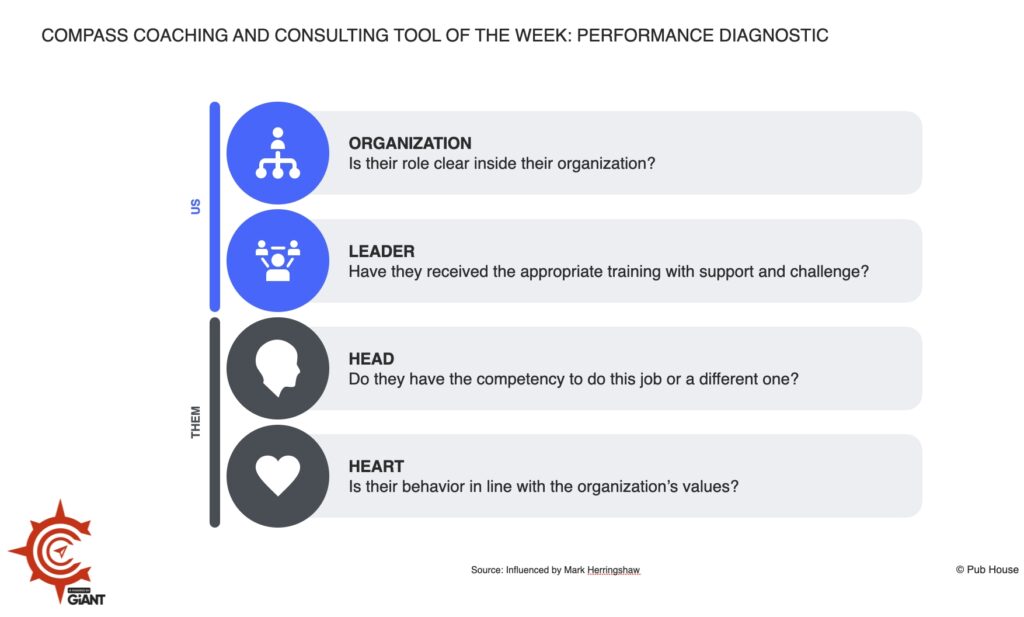Performance Diagnostic
What do you do when someone you lead or work with is not performing up to
expectations? To address this common issue, the Performance Diagnostic tool was developed. It helps us slow down, think through and identify—as well as address—the potential root causes of performance issues by examining organizational, leadership, and individual factors.
Organizational Analysis
The first step in the Performance Diagnostic process involves a thorough examination of the organizational context. This approach avoids premature blame and instead considers whether the organization has clearly defined roles and responsibilities.
Research from McKinsey & Company shows that clear roles and responsibilities can improve organizational health and performance by up to 25%(1).
The Performance Diagnostic tool helps us assesses whether the organization has clearly defined these elements. It also helps us assess external factors that might influence performance, such as recent organizational changes like mergers or restructuring. Understanding these elements is critical as they often have a significant impact on an employee’s ability to perform effectively.
Leadership Evaluation
The next focus area is on the leader’s role in the situation. According to a study by Gallup, managers account for at least 70% of the variance in employee engagement scores across an organization(2). This underscores the importance of leadership evaluation in connection with employee performance. The Performance Diagnostic tool prompts leaders to reflect on their own effectiveness.
As a leader, it is your responsibility to ensure that you have provided adequate training, support, and challenges to your team members. Reflecting on your leadership effectiveness in these key areas is essential. This introspection helps determine whether the performance issues might partially stem from your leadership style, thereby sharing some of the responsibility for the observed performance gaps.
Individual Assessment
Finally, if the performance issues appear to be centered on the individual, this tool helps evaluate two key areas: competency (HEAD) and alignment with organizational values (HEART).
A study published in the Journal of Business and Psychology found that “person-organization fit” significantly predicts job satisfaction, organizational commitment, and turnover(3).
This dual focus on competency and alignment with organizational values helps to determine whether the individual lacks necessary skills or if their behavior is out of alignment with the core values of the organization.
Depending on the findings, solutions might be reassigning the individual to a more suitable role or making the difficult decision to part ways if their values don’t align with those of the organization—even though they may be highly competent.
Collaborative Process
The diagnostic process is ideally a collaborative effort involving the leader, the individual, and possibly other relevant parties like HR or direct supervisors. Additionally, once the specific concerns have been identified, the means or path for improvement must be clear and constructive. Such discussions are crucial for realigning expectations and exploring role adjustments that could potentially improve conditions for all.
By engaging in this process together, it fosters an environment of mutual understanding and responsibility. This collaborative approach ensures that the assessment is fair and balanced, providing the individual with a comprehensive view of the factors affecting their performance. This approach aligns with findings from the Harvard Business Review, which emphasizes that effective performance management requires ongoing, real-time feedback(4).
Conclusion
By effectively utilizing the Performance Diagnostic tool to systematically address each aspect of performance issues, leaders can significantly enhance their effectiveness as a leader, fostering a supportive and high-performing team environment. Individual and team productivity will improve and a more engaged and motivated workforce will result.
As noted by Deloitte, organizations with effective performance management systems are 51% more likely to outperform their peers financially(5).
__________________________________________________________________________________
1 McKinsey & Company, “The Organization Health Index” (2017)
2 Gallup, “State of the American Manager” (2015)
3 Journal of Business and Psychology, “Person-Organization Fit” (2018)
4 Harvard Business Review, “The Performance Management Revolution” (2016)
5 Deloitte, “Global Human Capital Trends” (2019)

